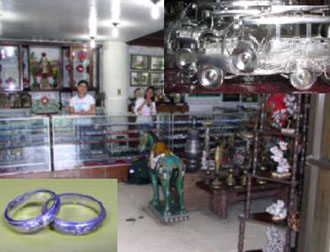| |
We are in Baguio, the "Summer Capital" of the Philippines. It's up in the mountains several hours North of Manila, so the weather is breezy and cool. It's a very nice change from blistering Manila. On our way here we stopped by Vigan, an well-preserved old Spanish colonial town on UNESCO's World Heritage list. We stayed in a quaint little inn with a canopy bed, owned by the family of an assassinated politician (rumored to be one of Marcos' casualties). For breakfast we had tosilog (rice, a fried egg, and sweet salted pork), and after visiting some well-preserved old buildings, we made our way to the bus station.
Bus travel in the Philippines is a heart-stopping string of near misses on bumpy two-lane roads populated mostly by other buses, jeepneys, motorcycles with sidecars, and the occasional horse and cart. The bus schedules don't even pretend to approximate regularity or precision. You just have to ask around, and people will give rough (within two or three hour) estimates of when the next bus bound for your destination will arrive at the bus station. IF the bus ever arrives. And that's not taking in to account the time while the bus sits in the station waiting to fill up with paying customers. The moral of the story is, always plan a full day for bus travel, no matter how short you think your bus trip will be.
While on the last leg of our journey to Baguio, we met Ronard, a very kind young engineer (who speaks some six or seven languages), who took us under his wing, helped us find a hotel, and showed us all around yesterday. We saw "The Mansion," a big house up on the hill with a gate that is supposed to be patterned after the gate at Buckingham Palace, and visited the botanical garden, a quaint little garden where winding paths bordered in lush vegetation are punctuated by replica Igarot houses on stilts. Today we're visiting Barnham Plaza, which was designed by an American architect who modeled it after Washington D.C. However, Baguio's most famous attraction is simply it's pleasant weather, such a rarity in the Philippines that no conversation is complete without a mention of the "natural air con" here. Their reverence for the cool weather is such that the main feature of the megamall here is that it is full of open verandas and requires no air conditioning.
We left our wedding rings at home in the states because we didn't want to lose them in the Philippines, so yesterday we visited a shop full of locally made silver jewelry and got matching elven rings (92.5% silver, 7.5% mithril. Only $12.00 for both). Tony also had business cards printed.
Ronard introduced us to a friend in Baguio, Jerry, a graduate student who prefers painting to thesis- riting. He is descended from the Igorots, the tribespeople native to this area. His paintings are amazing, and are on display at a few local galleries. When Tony asked him to pose for a photo with us, he took one off the wall and bequeathed it to us on the spot. Ronard invited us to Mass in the little university chapel. It was a pleasant service attended by a priest who spoke mainly in English with a sprinkling of funny stories in Tagalog. At the Mass we met Cesar and Faye, Ronard's hosts in Baguio, who invited us to dinner at their house. Highlights of the meal included fish intestine soup, pancit very skinny spaghetti rice noodles mixed with very fat ones), and sizzling sisig (pig's ear). Axa had milk.
Monday morning we're off on a whirlwind tour of the rest of the North, including Sagada, Bontoc and Banauae, after which we'll head south to explore the beaches and tropical rainforests, and to spend a month or so in the Cavite export zone interviewing manufacturers.
Love,
Tony, Sarah and Axa
|
|

Pictures from the bus to Vigan. |

Tosilog - a typical Filipino breakfast |

Top: Jerrie giving us one of his
paintings.
Bottom: Wandering through the
botanical gardens in Baguio with Ronard.
|

Purchasing our elven rings from a silver/mithril shop across from the botanical gardens. |

Tony's business card. :) |
|
|